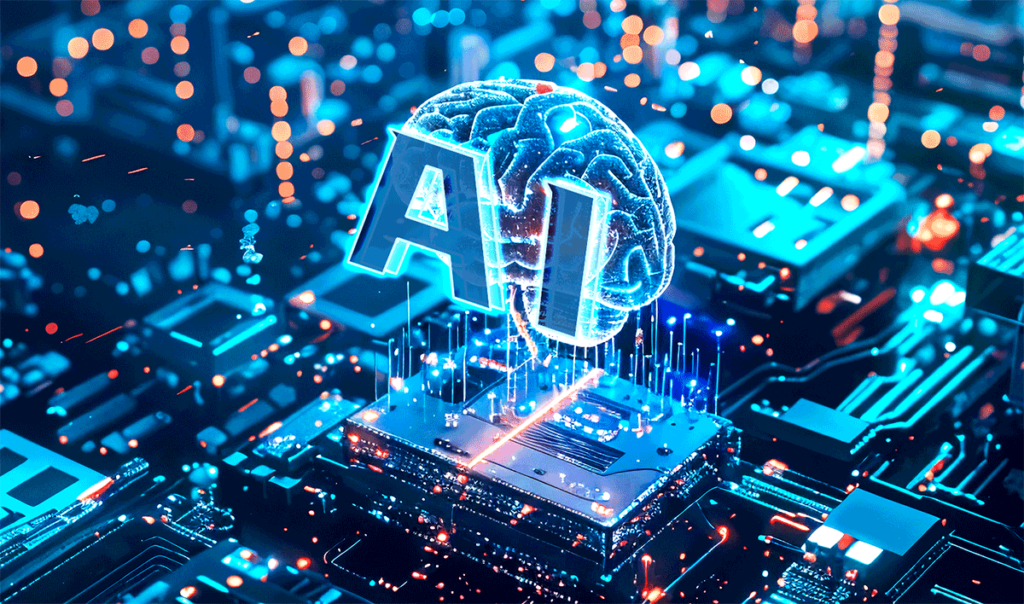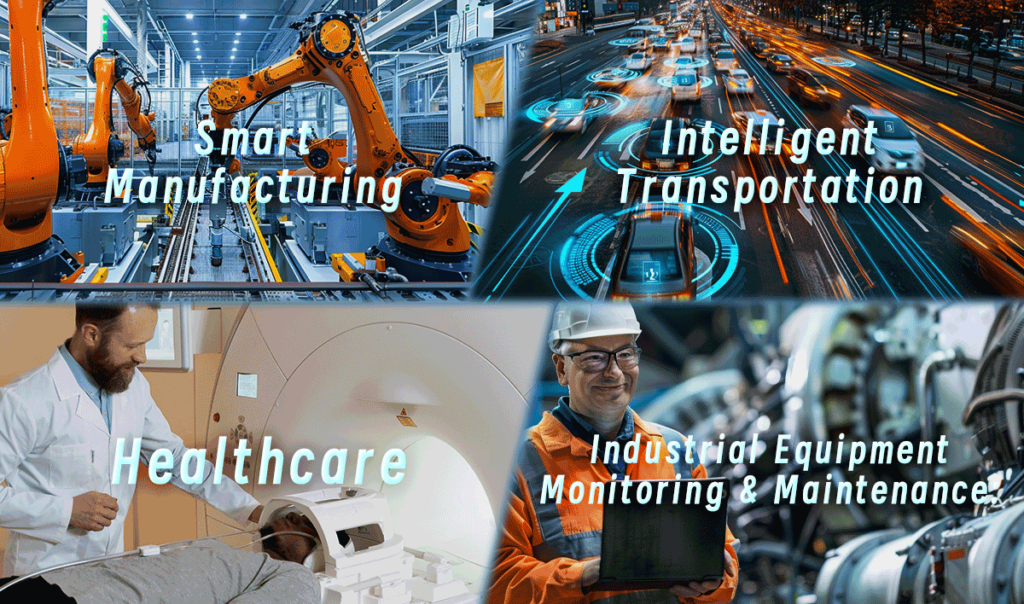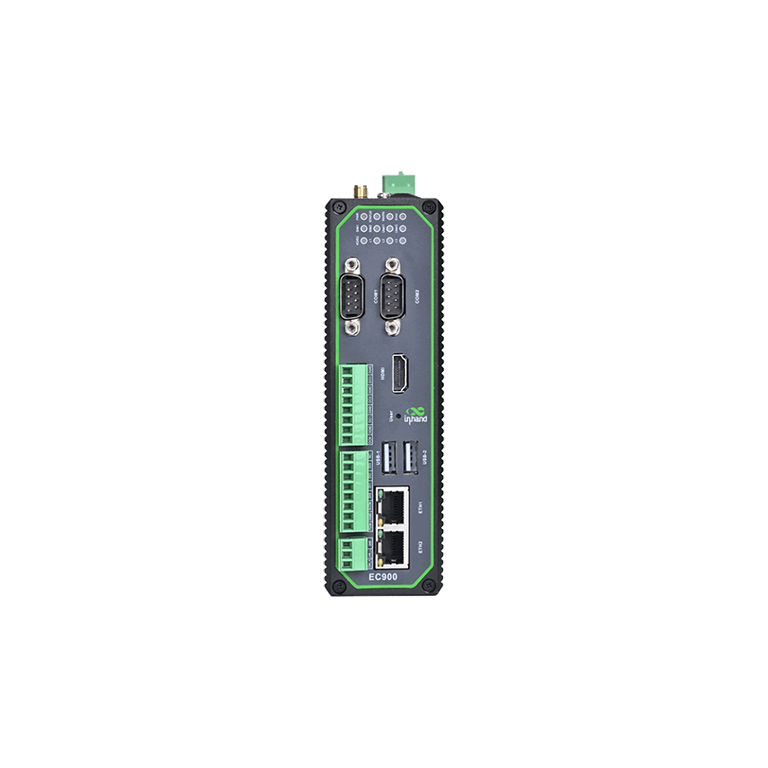
Con el rápido crecimiento del Internet de las Cosas (IoT) y la Inteligencia Artificial (IA), la demanda de procesamiento de datos y la complejidad que conlleva han aumentado considerablemente. La computación en la nube tradicional se enfrenta a limitaciones como la latencia, las restricciones de ancho de banda y los problemas de privacidad, lo que dificulta satisfacer las necesidades de procesamiento de datos en tiempo real. Inteligencia Artificial Edge-una tecnología que lleva los algoritmos y modelos de IA directamente a los dispositivos periféricos- ayuda a resolver estos retos. En este blog exploraremos qué es la IA Edge, las tecnologías básicas que la hacen posible, sus aplicaciones y sus ventajas únicas.
Comprender la IA Edge
La IA periférica consiste en ejecutar algoritmos de IA directamente en los dispositivos periféricos, lo que permite procesar los datos cerca de su origen en lugar de depender únicamente de la nube. Este enfoque tiene varias ventajas, como la reducción de la latencia, la mejora de la privacidad de los datos y una mayor eficiencia. Estas características hacen que Edge AI sea ideal para aplicaciones en áreas como la fabricación inteligente, la conducción autónoma y el IoT.

Tecnologías clave en Edge AI
La IA Edge se basa en varias tecnologías críticas para que el procesamiento local de datos sea eficiente y fiable. He aquí algunos de los componentes esenciales:
1. Aceleración por hardware
La IA Edge requiere una gran potencia de cálculo, que a menudo se consigue mediante componentes de hardware especializados diseñados para tareas de IA:
- Circuitos integrados para aplicaciones específicas (ASIC): Diseñados específicamente para funciones de IA, los ASIC ofrecen un alto rendimiento con un menor consumo de energía.
- Unidades de procesamiento gráfico (GPU): Conocidas por su capacidad para procesar datos en paralelo, las GPU son especialmente adecuadas para manejar tareas de IA complejas, como las redes neuronales.
- Matrices de puertas programables en campo (FPGA): Altamente adaptables, las FPGA pueden personalizarse para modelos de IA específicos, lo que las hace valiosas en los sistemas de IA de vanguardia.
- Unidades de procesamiento neuronal (NPU): Diseñadas específicamente para redes neuronales, las NPU son muy eficientes para cálculos paralelos de IA.
2. Optimización y compresión de modelos
Los dispositivos periféricos suelen tener una capacidad de almacenamiento y procesamiento limitada, por lo que los modelos de IA deben optimizarse para que funcionen sin problemas:
- Cuantificación de modelos: Convierte grandes parámetros del modelo en formatos más pequeños para reducir la carga computacional.
- Poda de modelos: Elimina conexiones sin importancia en una red neuronal, reduciendo su tamaño sin sacrificar la precisión.
- Destilación de conocimientos: Consiste en entrenar un modelo más pequeño para replicar los resultados de un modelo más grande, ahorrando recursos y manteniendo la eficacia.
- Esparcimiento de modelos: Reduce el número de parámetros de un modelo, mejorando la eficiencia computacional.
3. Arquitectura Edge Computing
Procesar y analizar los datos en el propio dispositivo requiere una arquitectura específica diseñada para funcionar en tiempo real:
- Arquitectura de dispositivos periféricos distribuidos: Los nodos de borde pueden trabajar de forma independiente, cada uno recopilando y procesando datos según sea necesario, especialmente en redes IoT.
- Colaboración Edge-Cloud: Mientras que algunas tareas se gestionan localmente, otras -como la formación de grandes modelos- se realizan en la nube, logrando un equilibrio entre rendimiento y latencia.
- Dispositivos periféricos interconectados: Los dispositivos periféricos pueden comunicarse directamente, lo que permite aplicaciones en tiempo real como la conducción autónoma y las fábricas inteligentes.
4. Sistemas operativos en tiempo real (RTOS)
Las aplicaciones Edge AI a menudo necesitan respuestas inmediatas, por lo que los sistemas operativos en tiempo real son esenciales para gestionar tareas sensibles al tiempo:
- Sistemas operativos ligeros: Sistemas como FreeRTOS y VxWorks están diseñados para sistemas empotrados, garantizando tiempos de respuesta rápidos incluso en hardware de bajo consumo.
- Contenedores y virtualización: Herramientas como los contenedores Docker y las máquinas virtuales hacen que los modelos de IA sean más portátiles y simplifican los procesos de despliegue y actualización.
5. Seguridad en los dispositivos periféricos
Dado que los dispositivos periféricos suelen interactuar directamente con los usuarios y el entorno físico, la seguridad y la privacidad son fundamentales:
- Cifrado de datos: Protege la información sensible durante su almacenamiento y transmisión.
- Arranque seguro: Garantiza que sólo se permite ejecutar en el dispositivo software y firmware verificados.
- Autenticación y autorización de dispositivos: Valida los dispositivos e impide el acceso no autorizado.
6. Comunicación en red y optimización de protocolos
Al funcionar a distancia, los dispositivos periféricos suelen depender de redes inalámbricas, por lo que unos protocolos eficaces ayudan a gestionar el intercambio de datos:
- Redes de área extensa de baja potencia (LPWAN): Protocolos como LoRa y NB-IoT admiten la transmisión de baja potencia a largas distancias.
- Tecnología 5G: Proporciona conectividad de alta velocidad y baja latencia adecuada para aplicaciones exigentes como la conducción autónoma y la asistencia sanitaria a distancia.
- Protocolos específicos de borde: MQTT y CoAP están diseñados para una transferencia de datos rápida y eficaz en entornos periféricos.
7. Informática heterogénea
Muchos dispositivos de borde incluyen distintos tipos de procesadores, como CPU, GPU, NPU y FPGA, cada uno adecuado para tareas específicas. Este enfoque se denomina computación heterogénea y maximiza las capacidades de cada tipo de procesador:
- Asignación de tareas: Distribuye las tareas al procesador más adecuado en función de los requisitos. Por ejemplo, las tareas sencillas pueden ejecutarse en una CPU, mientras que los modelos de IA complejos se procesan en una GPU.
- Informática colaborativa: Múltiples dispositivos de borde pueden trabajar juntos a través de una red, realizando varias tareas simultáneamente para acelerar el procesamiento de la IA.
8. Entrenamiento de modelos de IA localizados
Aunque los dispositivos periféricos se utilizan normalmente para la inferencia, algunos avances permiten el entrenamiento local de modelos, adaptando los modelos de IA en tiempo real a entornos específicos sin necesidad de enviar datos a la nube:
- Aprendizaje federado: Múltiples dispositivos de borde entrenan modelos de IA en colaboración sin compartir datos, protegiendo la privacidad.
- Aprendizaje incremental: Los modelos se actualizan gradualmente en los dispositivos de borde para adaptarse a entornos cambiantes, lo que resulta útil para aplicaciones como la vigilancia en tiempo real.
Aplicaciones de Edge AI

La IA Edge tiene usos prácticos en diversos campos, acercando la toma de decisiones inteligentes a la fuente de datos:
- Fabricación inteligente: En las fábricas automatizadas, la IA de vanguardia optimiza las líneas de producción, mejorando la eficiencia y la calidad del producto. Por ejemplo, puede supervisar los robots en la línea de producción y realizar ajustes en tiempo real para mantener una producción constante.
- Transporte inteligente: En los sistemas de transporte, la IA de vanguardia analiza el tráfico en tiempo real para controlar las señales, reducir la congestión y aumentar la seguridad vial. En los vehículos, los dispositivos de vanguardia permiten la comunicación directa entre coches, mejorando la fiabilidad de la conducción autónoma.
- Sanidad: La IA de vanguardia en sanidad permite controlar y analizar en tiempo real los datos de los pacientes. Por ejemplo, los dispositivos portátiles con algoritmos de IA pueden controlar las constantes vitales, como la frecuencia cardíaca y la presión arterial, y emitir alertas si se detectan lecturas anómalas.
- Supervisión y mantenimiento de equipos industriales: Edge AI ayuda a supervisar los equipos industriales, identificando posibles problemas antes de que se conviertan en tales. Mediante el análisis de datos históricos, también optimiza los programas de mantenimiento, alargando la vida útil de las máquinas.
Ventajas de Edge AI
Edge AI ofrece una serie de ventajas que la hacen idónea para las aplicaciones modernas:
- Baja latencia: Procesar los datos en el propio dispositivo significa tiempos de respuesta más rápidos, lo que es crucial para las aplicaciones en tiempo real.
- Uso eficiente del ancho de banda: Al procesar y filtrar los datos localmente, la IA de borde reduce la cantidad de datos enviados a través de la red, ahorrando ancho de banda y reduciendo los costes de transmisión.
- Mayor privacidad de los datos: El procesamiento local de los datos minimiza la necesidad de enviarlos fuera del sitio, lo que ayuda a proteger la privacidad del usuario.
- Escalabilidad y flexibilidad: Los sistemas Edge AI son adaptables, capaces de ampliarse o reducirse en función de la demanda, lo que resulta esencial en entornos diversos.
- Fiabilidad y autonomía: Los dispositivos Edge pueden seguir funcionando incluso sin conectividad a Internet, lo que garantiza el funcionamiento continuo de las tareas críticas.
Conclusiones: El futuro de la IA Edge
Edge AI está transformando la forma en que las industrias aprovechan la IA, acercando el procesamiento a la fuente de datos, reduciendo la latencia y permitiendo la toma de decisiones en tiempo real. Desde las fábricas hasta los vehículos autónomos, Edge AI está ayudando a las industrias a ser más inteligentes y a estar más conectadas. A medida que empresas como InHand Networks sigan innovando, Edge AI desempeñará un papel aún más importante en la configuración del funcionamiento de las empresas en el futuro.
